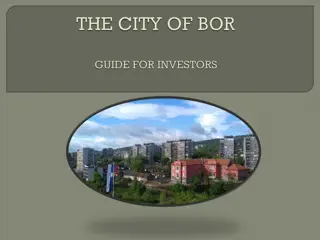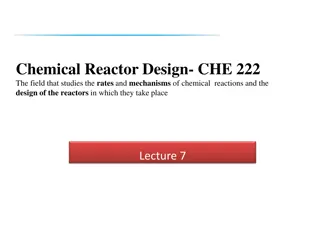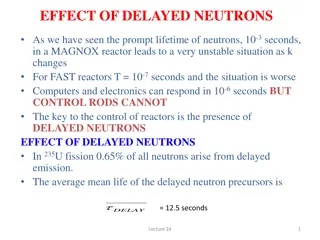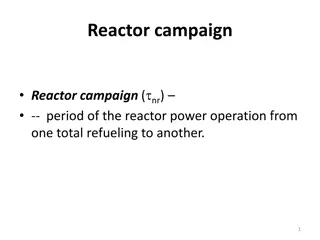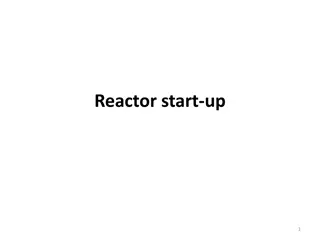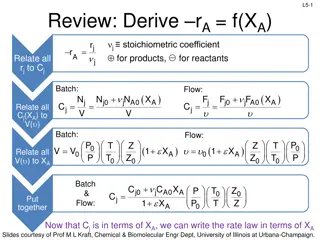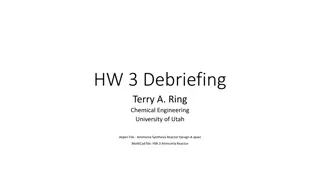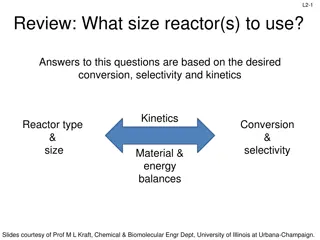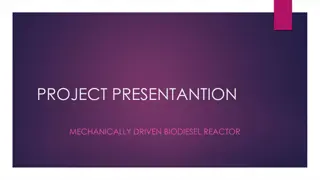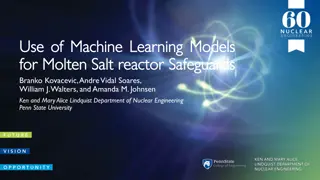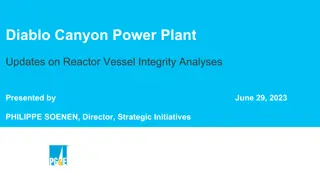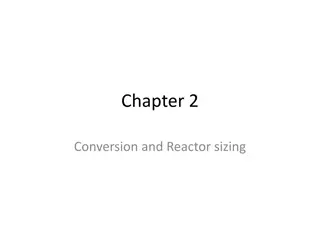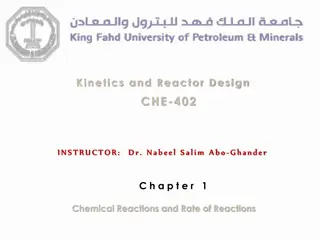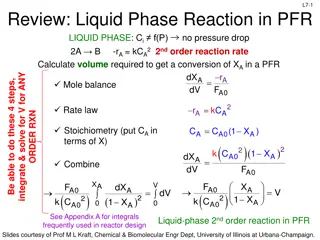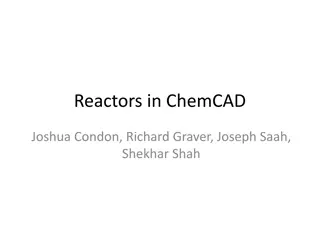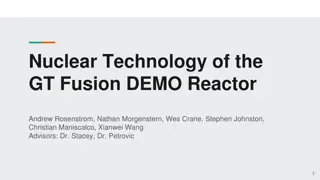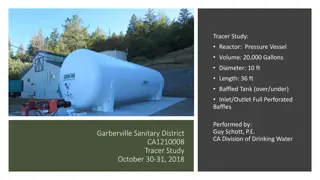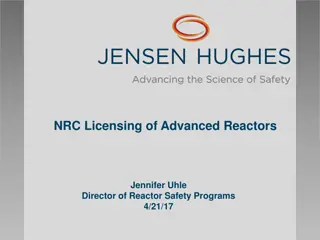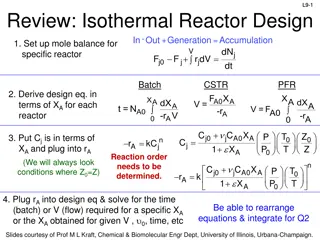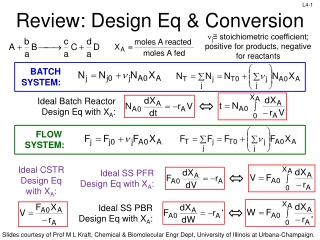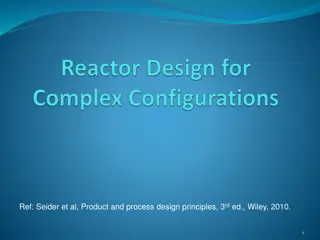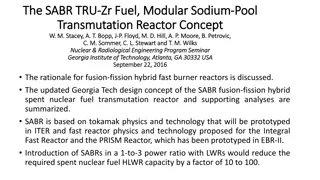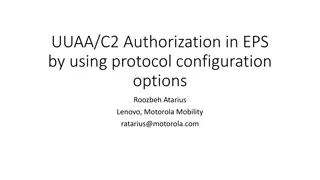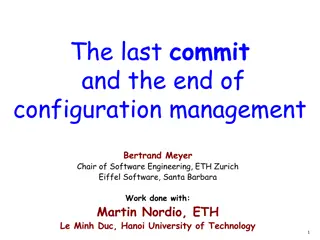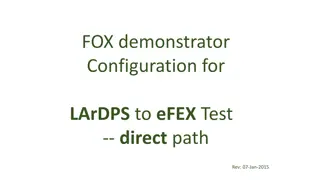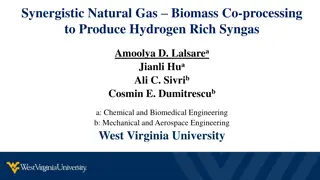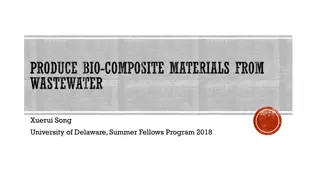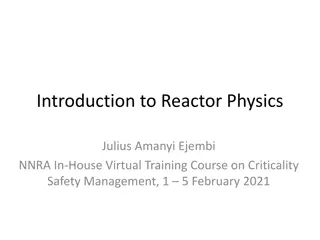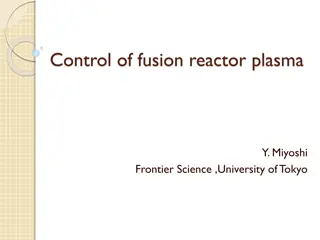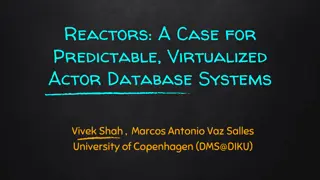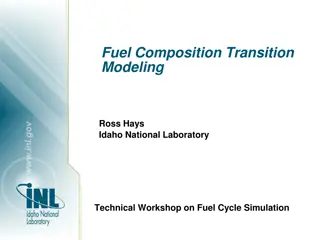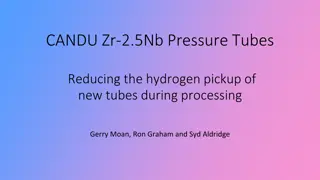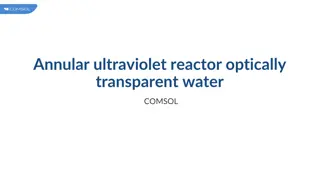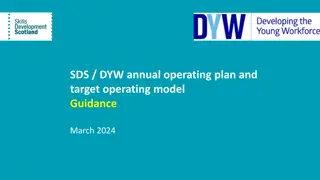BOR-60 Reactor Operating Experience and Design Configuration
The BOR-60 reactor, a key component of sustainable clean energy, has a rich history since its construction in the USSR. Its design configuration includes various components such as coolant inlet nozzles, control rod mechanisms, and fuel loading ducts. The core arrangement consists of control rods and standard and experimental fuel assemblies. Despite being over 51 years old, the reactor continues to be relevant today.
Download Presentation

Please find below an Image/Link to download the presentation.
The content on the website is provided AS IS for your information and personal use only. It may not be sold, licensed, or shared on other websites without obtaining consent from the author. Download presentation by click this link. If you encounter any issues during the download, it is possible that the publisher has removed the file from their server.
E N D
Presentation Transcript
BOR-60 reactor operating experience, work on improving safety and extending lifetime International Conference on Fast Reactors and Related Fuel Cycles: Sustainable Clean Energy for the Future (FR22), 19-22 April 2022, Vienna, Austria A.L. Izhutov, A.L. Petelin, Yu.M. Krasheninnikov, I.Yu. Zhemkov, V.B. Kharlov Research Institute of Nuclear Reactors, State Scientific Centre, Joint-Stock Company (RIAR JSC)
Milestones of the BOR-60 reactor construction: the USSR Council of Ministers issued a decree on the BOR-60 reactor construction; beginning of earth construction; pre-nuclear commissioning of the BOR-60 reactor; September 1964 May 1965 December 1968 commissioning of the start-up facilities at phase 1 construction work; BOR-60 attained its first criticality; BOR-60 power start-up with heat removal to the air heat exchanger; 30 December 1968 14 December 1969 28 December 1969 commissioning of the BOR-60 plant on a full scale, output of generated electrical power into the Ulyanovskenergo system. 28 December 1970 In December 2020 reactor celebrated 51-year anniversary of its power startup. Despite its honorable age (>51 y.), the reactor remains in demand to this day. 2
BOR-60 design configuration 1 coolant inlet nozzle; 2 high-pressure device; 3 basket; 4 thermal protection and neutron shielding of the reactor vessel; 5 containment vessel; 6 outlet nozzle; 7 vessel flange; 8 in-core FAs and FAs in the lateral blanket; 9 control rod drive mechanism; 10 fuel loading duct; 11 supporting flange; 12 large rotating flat plug; 13 small rotating flat plug. 3
BOR-60 core arrangement 11 11 11 11 11 11 11 11 Control road BA BA BA BA BA BA BA BA 10 03 04 08 14 20 29 01 11 11 11 11 11 11 11 11 11 11 11 BA BA BA BA BA BA BA BA BA BA BA 01 35 34 38 40 02 09 18 25 35 10 11 11 11 11 4 4 4 11 11 11 11 11 BA BA BA BA FA FA FA BA BA BA BA BA 29 25 24 27 30 36 42 06 16 24 34 03 Standard fuel assembly 11 11 11 11 4 11 4 4 14 11 11 11 11 BA BA BA BA FA BA FA FA BA BA BA BA CR 20 18 16 19 21 26 33 41 07 19 27 38 04 11 11 4 6 4 4 4 4 4 4 4 4 11 11 BA BA FA EFA FA FA FA FA FA FA FA FA BA BA 14 09 06 07 11 17 23 32 44 11 21 30 40 08 11 11 4 4 4 4 6 4 4 4 4 4 10 11 11 EMA BA BA FA FA FA FA EFA FA FA FA FA FA BA BA 08 02 42 41 44 05 13 22 37 05 17 26 02 14 36 Experimental fuel assembly 11 11 4 4 4 13 4 4 12 4 4 4 4 4 11 11 BA BA FA FA FA FA FA FA FA FA FA FA BA BA CR CR 04 40 36 33 32 37 43 12 28 43 13 23 33 42 09 20 11 11 11 4 6 4 4 4 4 4 4 4 4 4 16 11 11 BA BA BA FA EFA FA FA FA FA FA FA FA FA FA EMA BA BA 03 38 30 26 23 22 28 39 15 39 12 22 32 41 06 18 29 11 11 11 4 4 4 4 6 4 4 10 4 4 4 4 11 11 11 BA BA BA FA FA FA FA EFA FA FA EMA FA FA FA FA BA BA BA I heard you threw your gamepad 11 11 11 4 4 4 4 10 4 FA FA FA BA BA EMA FA BA FA Experimental non-fuel assembly 10 34 27 21 17 13 12 15 31 31 15 28 37 44 07 16 25 01 11 11 11 4 4 12 4 4 13 4 4 4 6 4 11 11 11 BA BA BA FA FA FA FA FA FA FA EFA FA BA BA BA CR CR 35 24 19 11 05 43 39 31 10 31 39 43 05 11 19 24 35 4 10 4 4 4 4 11 11 11 FA EMA FA FA FA FA BA BA BA 01 25 16 07 44 37 28 15 31 31 15 12 13 17 21 27 34 11 11 11 4 6 4 4 4 6 4 4 10 4 4 6 11 11 Neutron source EMA BA BA BA FA EFA FA FA FA EFA FA FA FA FA EFA BA BA 29 18 06 41 32 22 12 39 15 39 28 23 26 30 38 03 22 11 11 4 4 4 4 6 4 4 4 4 4 4 4 11 11 BA BA FA FA FA FA EFA FA FA FA FA FA FA FA BA BA 20 09 42 33 23 13 43 28 12 43 37 32 33 36 40 04 11 11 10 4 4 4 4 4 4 12 4 4 4 11 11 BA BA EMA FA FA FA FA FA FA FA FA FA BA BA CR 14 02 36 26 17 05 37 22 13 05 44 41 42 02 08 Blanket assembly (steel) 11 11 10 4 4 4 4 4 4 4 4 11 11 11 BA BA EMA FA FA FA FA FA FA FA FA BA BA BA 08 40 30 21 11 44 32 23 17 11 07 06 09 14 11 11 15 11 4 4 14 4 4 11 11 11 11 BA BA NS BA FA FA FA FA BA BA BA BA CR 04 38 27 19 07 41 33 26 21 19 16 18 20 11 11 11 11 4 4 4 11 11 11 11 11 BA BA BA BA FA FA FA BA BA BA BA BA 03 34 24 16 06 42 36 30 27 24 25 29 Instrumented irradiation position D23 11 11 11 11 11 11 11 11 11 11 11 BA BA BA BA BA BA BA BA BA BA BA 10 35 25 18 09 02 40 38 34 35 01 11 11 11 11 11 11 11 11 BA BA BA BA BA BA BA BA 01 29 20 14 08 04 03 10 4
Main operational parameters of the BOR-60 reactor Thermal power output, MW Electrical power output, MW Cogeneration plant capacity, Gcal/h Maximal neutron flux density, cm-2 s-1 Coolant Sodium flow rate through the reactor, m3/h Coolant temperature, : Up to 60 12 25 3.7 1015 sodium Up to 1100 at the reactor inlet, 360 at the reactor outlet, 515 Sodium velocity in the core, m/s Sodium flow rate in two secondary loops, m3/h Output of the sodium-to-air heat exchanger, MW Reactor operation cycle, days Shutdown time between the reactor operation cycles, days Damage dose rate, dpa/yr Up to 8 Up to 1400 30 Up to 90 20 and 45 Up to 20 5
BOR-60 flow diagram 1 reactor; 2, 5, 7, 11 primary and secondary pumps; 3, 10 intermediate heat exchangers; 4, 8 steam generators; 6 air heat exchanger; 9 turbine; 12 cogeneration plant for district heating. 6
Main operational performance data of BOR-60 Performance indicator 2016 2017 2018 2019 2020 5365 5669 5157 5249 5078 Effective full power hours, h 0.63 0.65 0.59 0.6 0.57 Installed capacity utilization factor 50 50 50 50 50 Maximal power output of the reactor, MW 245 265 223 220 222 Heat generation, GW h 34.7 38.5 32.1 28.5 29.6 Electric power generation, GW h 31560 37779 34991 27153 24657 Heat generated by cogeneration plant, Gcal The number of reactor shutdowns: total scheduled outages unplanned outages 8 8 0 5 4 1 9 9 0 4 4 0 6 6 0 Outages hours due to unplanned reactor shutdowns, h 40 7
Experimental capabilities of the BOR-60 The main directions of irradiation testing and work at the reactor: Large-scale irradiation tests of fuel rods with various fuel compositions; Irradiation testing of neutron absorbing materials; Irradiation tests of structural materials for fuel rods, absorber rods, fuel test rigs as well as testing of vessels, equipment and pipe ducts for different reactors; Experiments in support of reactor safety to cope with the abnormal operating occurrences; Inserting experimental fuel assembles and materials test rigs both in the core and lateral blanket; Irradiation position to insert instrumented materials test rigs, fuel assemblies or independent loop channels so that to obtain experimental data during irradiation testing; Irradiation testing of specimens in dry horizontal (2 pcs.) and vertical (9 pcs.) channels outside the reactor vessel; Experiments focused on sodium-cooled reactor technology (sodium purity, purification of sodium coolant and removal of radionuclides, cleaning of equipment from sodium and radioactive sodium among other things, sodium waste removal, etc.); Testing of reactor operation in the NPP mode for which a steam turbine makes a part of the reactor. Simultaneous testing of prototype equipment intended for operation in sodium-cooled circuits as well as diagnostic and safety systems. 8
The main experiments and irradiation tests conducted in the BOR-60 reactor in recent years Irradiation testing of materials test rigs with structural materials test specimens (zirconium alloys and structural materials for components of different reactors) in a temperature range of 320 650 ; Irradiation testing of absorber rodlets with high-enriched boron carbide and prototype fuel rods for the SVBR-100 reactor; Irradiation testing of the BREST-OD-300 absorber rodlets filled with boron carbide pellets and lead bonding, dysprosium hafnate pellets and helium bonding; Irradiation testing of prototype BREST-OD-300 nitride fuel rods; Irradiation testing of zirconium alloys under the Contract with EDF (France); Irradiation testing of structural materials test specimens under the Contracts with CEA (France), Terra Power (USA) and KAERI (the Republic of Korea); Irradiation testing of radiation shielding material (granular corundum) for the MBIR reactor; Irradiation testing of vibropack MOX prototype fuel rods for the MBIR reactor; Irradiation testing of absorbing materials specimens under the Contract with (France); The number of test rigs under irradiation testing in the core and lateral blanket ranged from 15 to 24. 9
Work on extending the service life and improving the safety of the BOR-60 It is worth to highlight the following among the most significant activities undertaken in recent years to enhance the reactor safety: Replacement of the obsolete measuring equipment of the process control system; Replacement of the obsolete equipment of the electrical heating control system for sodium circuits; The process control system of the III circuit was upgraded; Four power transformers were replaced from 2014 to 2017; In 2017 an automatic dry chemical fire suppression system was installed in the cable corridor; In 2018 the following equipment was installed and put into operation: storage battery with a capacity of 920 A h; 108 cells with voltage output of 220 V; two charging units for storage batteries; electric power supply system of the BOR-60 data acquisition and measurement system; In 2019 ASUZ-22R equipment was put into operation; In 2020 the following equipment was replaced and new one was put into operation: Four power transformers; Uninterruptable power supply units of emergency power supply system; Radiation monitoring system of the BOR-60 reactor; Two water heaters for the III circuit; Fittings for the III circuit (18 pcs.). 10
Prospects of the BOR-60 reactor From 2018 to 2019 the BOR-60 reactor was inspected holistically. The results of this inspection were used as a basis to make a decision to extend the life of the reactor till December 31, 2025. The documents pertinent to the BOR-60 life extension were submitted to specialized organization for expertize and its conclusion was favorable for granting the license to extend the BOR-60 life till the end of 2025. Nowadays the BOR-60 reactor is in great demand to conduct irradiation tests for both Russian and foreign customers. Most of the experiments are long-term. The BOR-60 reactor has secured contracts for the next few years and irradiation tests will continue until it is decommissioning. It is therefore important to ensure its safe and efficient operation during its extended life and to optimize the reactor loading in order to make more rational use of the core to meet the demand for irradiation tests. 11
Thank you for your attention Alexey Izhutov Deputy Director, Science&Research RIAR JSC, Dimitrovgrad Tel.: +7 (84235) 7-93-40 E-mail: adm@niiar.ru


